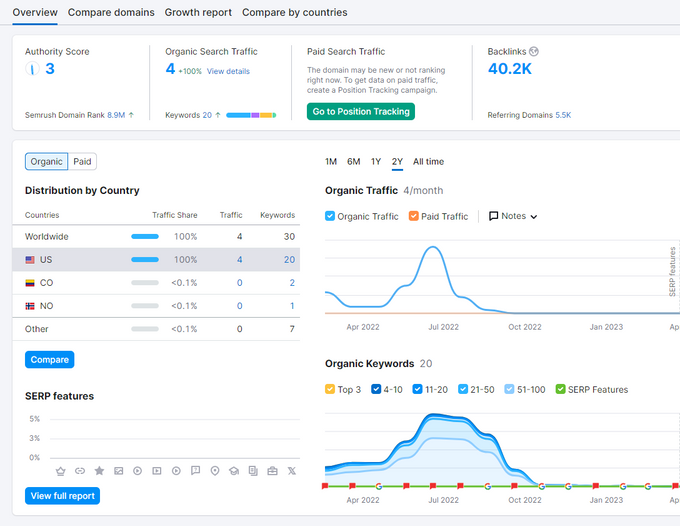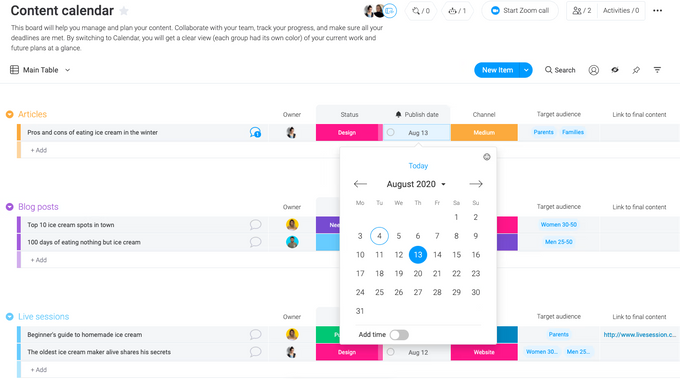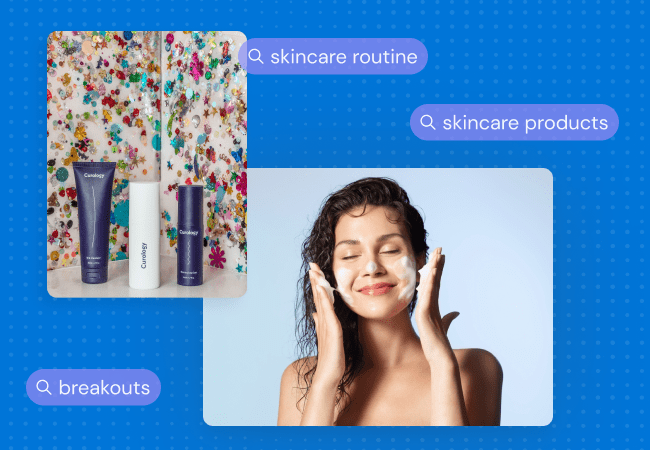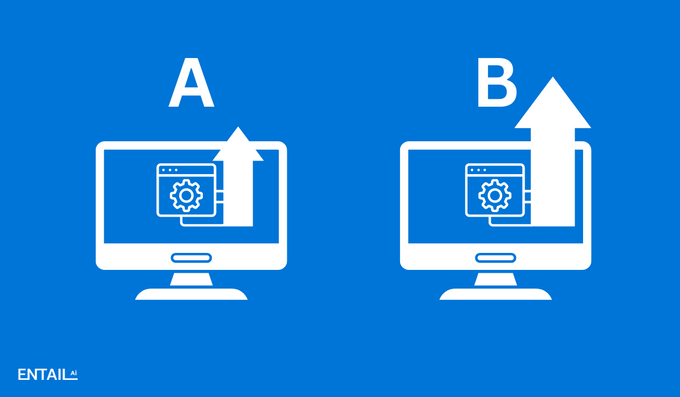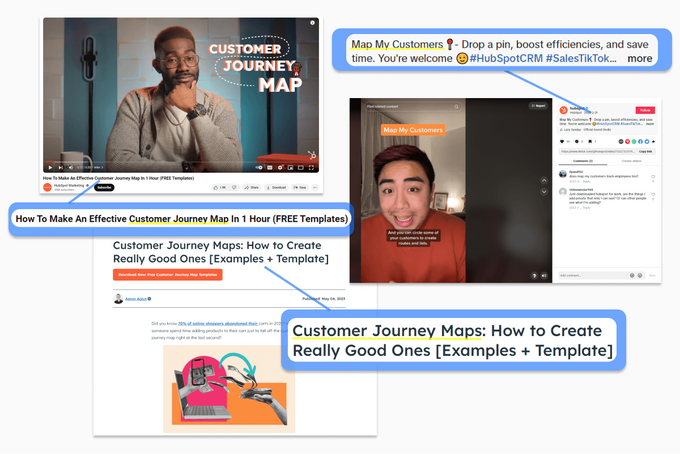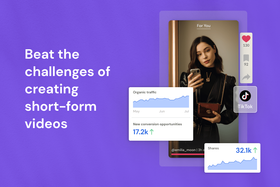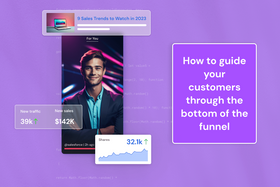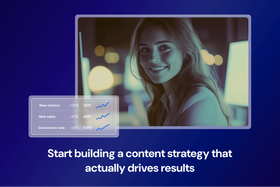Creating a high-converting content strategy: A step-by-step guide
Building a content strategy is an absolute must when you want to produce valuable content that converts users into customers.
Updated November 11, 2024
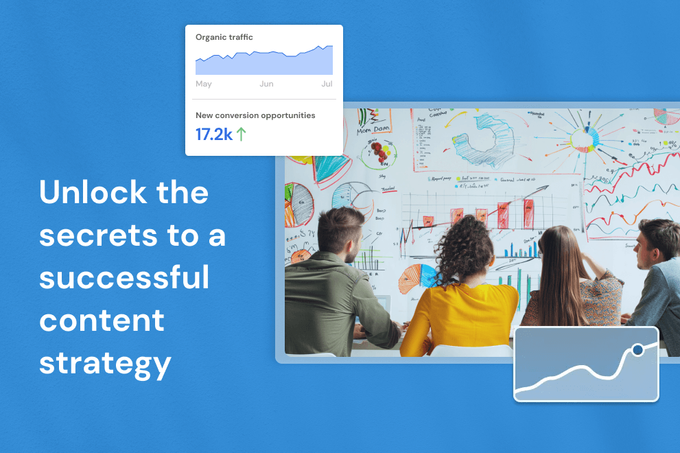
Key takeaways
- A well-defined content strategy is key to an effective content creation and distribution process.
- Understanding your audience and what you can offer them should be your starting point.
- Approach your strategy from a video-first perspective to meet modern audiences' expectations.
- As part of your strategy, adapt and repurpose your core content across various platforms and formats.
Content is the cornerstone to connecting with your audience. Without an action plan to make it work, you won't be able to achieve your goals of reaching and converting your target audience.
Plus, with the democratization of content creation through generative AI leading to a surge in content production, you have to create the right content for the right people at the right time. A content strategy is the first step to doing this effectively.
Why you need a content strategy
In business, all content must be justified by some kind of return on investment (ROI)—whether tangible in the form of sales profits or achieving other conversion goals. That's where strategy comes in.
Having a content strategy enables you to:
- Eliminate ambiguity and stick to your niche: You need to understand what content to create, which topics to focus on, and why.
- Effectively target your audience: Developing your strategy helps you to understand and target your audience's pain points, needs, and interests.
- Develop the right content: Your content needs to deliver valuable, in-depth, and relevant information. This also helps you build topical authority.
- Guide users through the funnel: You want to nudge users toward conversion by addressing their needs at every funnel stage.
- Invest strategically: A solid content strategy can help you use your finite amount of resources and capital as effectively as possible.
- Measure and adapt: With a strategy comes measurable outcomes that allow you to see what's working and improve what isn't.
» Learn how to create content that converts.
8 steps to an effective content strategy
1. Research your audience
You can't be everything to everyone. You need to strategically approach people if you want to reach them. In content creation, this means understanding your audience incredibly well if you want to succeed.
Use audience analytics tools like Google Analytics, SimilarWeb, and Audiense. To find topics to guide your content creation process, you can use SEMRush and Google Trends.
Throughout your research, think about your audience in terms of what they need, what they want, and how you can meet their expectations.
2. Develop your brand voice
Make sure you understand your audience, how they speak, and how they prefer to be spoken to. Then, think about your business's mission and values. Combine these elements to get started on your voice. Remember, this is your brand's personality. You want to use your voice to clearly communicate your brand's value to your audience.
Ask yourself how you want to be perceived, what emotions you want to evoke in your audience, and how you can reflect your brand's personality in your content. Are you a fun, easy-going lifestyle brand or a more serious and professional financial institution? These questions play into how you portray your brand.
» From the podcast: Ari Yablok explains how to build a brand.
3. Set clear goals
Your main goal is usually to lead your audience to conversion. But you need to think about how you can achieve that goal through your content. Leading potential customers through the sales funnel with content that meets potential customers at different stages is the best way to achieve this overarching goal. Consider these goals to get your audience to the conversion stage:
- Build trust: Prove to your audience that you're a business that can be trusted. Use different types of content that demonstrate topical authority, such as expert insights into a particular pain point.
- Educate your audience: Selling is not the be-all-and-end-all of content strategy. You want to deliver helpful and valuable content to your audience that is well-researched so you can provide information and practical solutions.
Additional goals for near the bottom of the funnel include:
- Increase traffic: Good content comes before traffic. If you want to achieve this goal, you need to make sure you've achieved the first two well enough to drive users to your site.
- Capture leads: Once you've got traffic to your site, you need to make it work for you. Include CTAs that drive specific actions to encourage visitors to make a purchase or leave their email addresses for future nurturing.
- Nurture leads: By consistently producing content that informs and adds value to your audience, you can turn those leads into sales. More direct CTAs and product content can help you meet this goal.
- Build a strong customer base: We're looking at retaining customers at this stage. To work on this goal, you need to create content that continues to add value to the customer after the sale is complete. Give them additional information about the products and use cases they might be interested in. Additionally, support content such as user guides and knowledge bases can help your customers stay loyal.
4. Set up metrics to track performance
You will have different metrics depending on your goals. Common metrics to consider when measuring content performance are:
Website traffic and engagement:
- Page views: The total number of times your content pages have been viewed.
- Unique visitors: The number of distinct individuals who visited your website.
- Bounce rate: The percentage of visitors who leave your site after viewing only one page. A high bounce rate may indicate that your content isn’t engaging enough.
- Time on page: How long visitors spend on a specific page. Longer time indicates higher engagement.
Conversion metrics:
- Conversion rate: The percentage of visitors who take a desired action, such as signing up for a newsletter, making a purchase, or downloading a resource.
- Click-through rate (CTR): The percentage of users who click on a specific link (e.g., a call-to-action button).
- Lead generation: Track how many leads (email sign-ups, form submissions) your content generates.
SEO performance:
- Keyword rankings: Monitor how your content ranks for relevant keywords in search engine results.
- Organic traffic: The number of visitors who find your content through search engines.
- Backlinks: The number and quality of external websites linking to your content.
Social media metrics:
- Shares, likes, and comments: Measure engagement on social media platforms.
- Follower growth: Track the growth of your social media audience.
- Referral traffic: How much traffic your content receives from social media channels.
Content-specific metrics:
- Content performance: Analyze which pieces of content perform best (e.g., blog posts, videos, infographics).
- Dwell time: How long users spend consuming your content.
- Content reach: The number of people who see your content (including shares and reposts).
5. Create a content calendar
Using a content calendar in your strategy is invaluable for organizing and planning how you distribute your content. It helps you visualize and achieve your short-term and long-term content goals.
By using a content calendar, you can easily identify gaps in your content pillars or topic clusters and themes. It also keeps you on track with producing the valuable content your audience needs and aligns your content with specific funnel stages and business goals.
Content calendars are useful for maintaining consistency, which breeds brand credibility. Your audience will know that you will produce content they want or need regularly and trust you as an authority in your domain.
6. Create valuable content
At this stage of implementing your strategy, you have the necessary insights and approaches lined up to start producing interesting and valuable content for your audience.
Start creating content that aligns with your brand and your audience's needs by focusing on topic clusters. Take a topic that interests your audience then link that to your business goals and expertise. From there, you can develop your content to fully educate, inform, and nurture your audience.
» Build authority and share value by creating authentic, expert content.
7. Measure performance
Now that you have some content, you can begin measuring how it performs. Use the metrics you highlighted according to your goals in step 4 and start measuring.
When you measure the performance of your content, pay attention to the whole content ecosystem you've created and check what your audience is actually consuming. This can show you which efforts to double down on and which to scale back.
8. Optimize content
Take note of the content that performs best and learn from your successes. Failed content isn't the end, though. Work towards understanding why certain content types or topics aren't performing and optimize them accordingly.
You can also optimize content for your specific goals. If you don't see users taking action on content that is specifically intended to convert, try using different CTAs or page layouts with A/B testing to see what will result in the desired action.
» Explore expert strategies to optimize the bottom of your marketing funnel.
Essential tips to improve your content strategy
With the rise of generative AI, along with ever-changing consumer tastes, we have to adapt our approach to captivate audiences with fresh, engaging content across various platforms.
Here's how.
Create content with experts
People want expert insight, personal perspectives, and experiences. You need to update your content approach to meet the mandates of trust, authenticity, and expertise to compete.
Seek out experts in the field you want to create content for and work with them to develop content that meets the needs of your audience. For example, if you're creating content for people with flat feet, you want physical therapists, orthopedists, or podiatrists to be the content creators.
» Find reliable experts to create your content.
Put video first
Another big change in the content creation market is a swift move toward more video. 92.3% of social media users consume video daily—short-form videos specifically.
With the rise of TikTok as a major player in social media, we've seen a shift towards more video consumption than ever before. More B2C and B2B brands are finding value in TikTok as it continues on its rise. To reach even more customers, try creating videos for social media.
» Get high-quality expert videos at scale.
Repurpose your content
One of the advantages of starting with video first is that it can be used to create a range of other content types.
Suppose you start with a long-form interview with an expert. You can publish that as a podcast and YouTube video first. From that, you can create a range of short-form videos for YouTube Shorts, Instagram Reels, and TikToks. These all feed into the main topic cluster and satisfy the needs of the audiences on different platforms.
You can also create blog posts or guides in text format based on the insights from those expert interviews. It's a great way to get a lot of content out in various forms and on different platforms but remember to not simply duplicate content. Your audience still wants value from you, and simply duplicating content will affect your SEO rankings and decrease engagement from your audience.
Great content starts with a solid strategy
A well-defined content strategy is a necessity for any brand aiming to carve out its space online. From understanding your audience's needs to tailoring your brand voice and setting measurable goals, the roadmap to effective content creation is clear.
Once you've created your content, take it further and use data to drive your future content creation. Consistently adapting your strategy based on what you see performing is key to staying on top of the content game.

